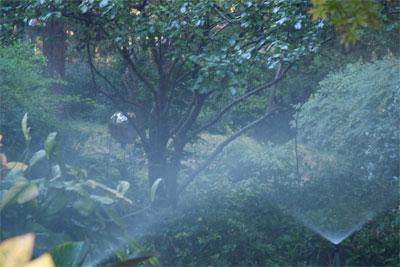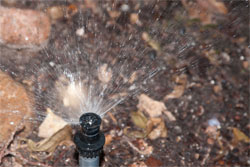Special Tips on Winter Water Conservation


Many Texas cities are in, or soon will be in, Stage 3 water rationing programs. The regulations may vary, but many call for watering only once every two weeks. While that would be disastrous during the hot days of late spring, summer and early fall, we should be able to get our lawns and landscapes through the winter intact under those regimens. Hopefully, rains will replenish our reserves by next summer. In the meantime, let’s see what we can do for today.
Before I go any further, please let me say that I fully support responsible consumption of irrigation water. We have always wasted way too much water. In hopes of turning that pattern around at least a little, I offer the following thoughts.
• We water too often. Learn to recognize symptoms of dry plants, then water deeply — and only when needed. Never water "every day," "every other day," etc. Water according to need, not according to the calendar. That caution doesn’t figure in now, however, since we’re not allowed to water that often anyway.
• Conversely, there are people among us who have let plants die, when only a few buckets of water might have saved them. Nice Asian jasmine beds and holly borders could have been saved had they been watered just a few times over the summer. Let’s keep common sense in our decisions. How much time, money and effort is it going to take to replace plants if we let them go dry? Don’t make decisions you’ll regret later.
• If we have automatic sprinkling systems, we need to maintain them regularly. Heads become broken, missing, misaligned, or blocked. Valves develop leaks. Time needed for the various stations to water properly may change, but we often don’t go to the trouble to make adjustments.
• Only a few of us have "smart" controllers yet. These special sprinkler clocks are set to measure local weather conditions and balance them against soil types, plant species, sun/shade, slope/flat ground and other variables to determine when sprinklers should run, and how long they should run. You can save a great deal of money — and likewise, water — through the use of these controllers. Installation cost is only a few hundred dollars. You’ll probably recover that within just a few summer months.
• Mulches perform many functions. Winter protection of tender plants is one of the best-known reasons to mulch, but mulches also reduce the soil-air contact, slowing the drying of the soil. Doubt if it works? Lay a piece of waxed paper or plastic wrap loosely over a wet washcloth to see how it slows drying. Mulches also slow the flow of water, letting irrigation and rainfall soak in better, with less loss to runoff. And mulches inhibit the growth of weeds, those robbers of soil moisture. Mulches are ideal investments from every possible standpoint.
• You don’t have to stop gardening during droughts. Just shrink the amount of ground that you try to tend intensively. Grow winter color plants in large patio pots, and position them where you’ll get the best show for your dough. That will mean far less watering than flowers in big beds require. When spring arrives, concentrate on your family’s favorite vegetables, particularly those that don’t use lots of space. Since many of us prepare our spring garden spaces in the fall (so we can include shredded tree leaves in the mix), I thought I’d give you this tip a bit early.
• Above all, my recommendation is that we make a commitment not to landscape and garden to the extremes. Sure, we’re in a biblical drought, but that doesn’t mean that we’re always going to be this dry. If you live in the eastern half or third of Texas, don’t feel like you must convert your gardens exclusively to those xeriphytic plants from the arid areas of far West Texas. Let common sense prevail. This rough time, too, shall pass.
